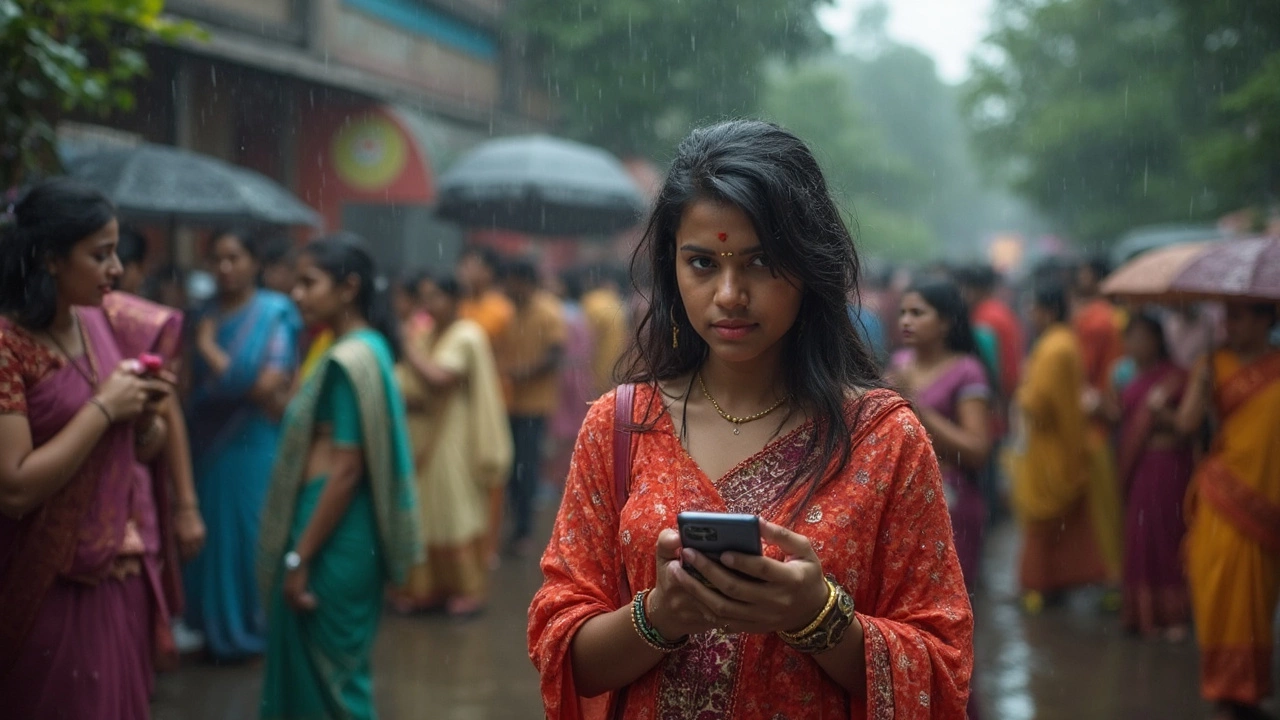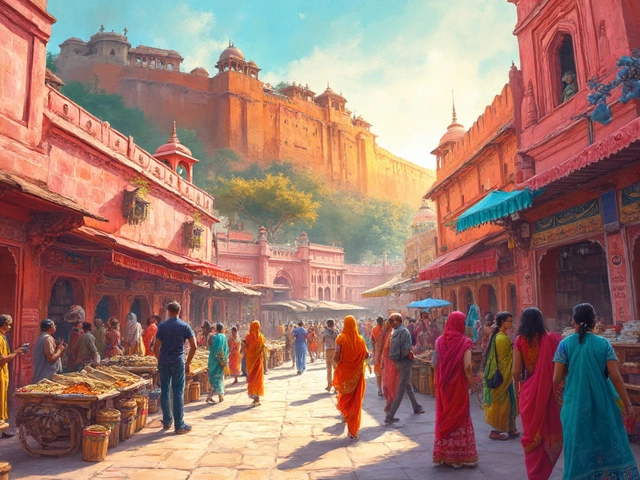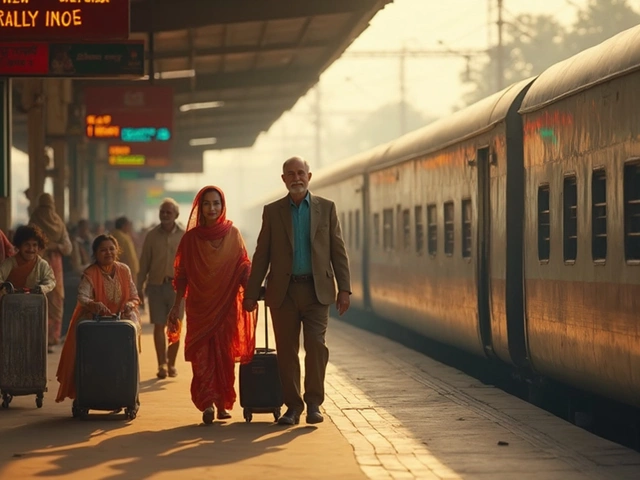Imagine standing in line for hours, only to realize you picked the worst day to visit a temple. It happens all the time, especially in India. Temples can get insanely crowded, and not every moment is the right time to go. If you want a peaceful visit—and want to avoid sweaty crowds, sudden closures, or awkward stares—it's all about timing.
One of the most common mistakes? Showing up on a festival day without realizing it. The crowd doubles, the heat feels worse, and the whole vibe changes. Local events can turn a simple visit into a test of patience. Knowing when not to go can be just as important as knowing when to go.
There are also temple timings to consider. Some temples open for a few hours, close in the afternoon, and open again later. Miss this window, and you might be stuck outside with nothing but your shoes and some street food vendors for company.
- Crowded Days and Local Festivals
- Off-Hours and Temple Closures
- Traveling During Extreme Weather
- Personal and Cultural Restrictions
- Smart Tips for a Smooth Visit
Crowded Days and Local Festivals
If you want a calm experience, you’ll want to skip the days when everyone in town and their relatives show up at the temple. In India, temples aren’t just places for quiet prayer—they’re the heart of festivals and rituals. Some days, it feels like the whole city drops by, and that includes tourists from far and wide.
The biggest traffic jams? Those happen during festivals like Diwali, Maha Shivratri, Navratri, and Janmashtami. For example, during Navratri at the Vaishno Devi temple, almost 3 to 4 lakh (that’s 300,000 to 400,000) pilgrims visit daily. Tirupati Balaji sees over 1 lakh (100,000) visitors on temple tours India every day during Brahmotsavam. Even smaller temples get flooded with crowds during local temple anniversaries or “Pran Pratishtha” ceremonies.
If you really want to experience the temple’s regular vibe, check for these local events ahead of time. Here’s a quick guide to some famous temples and their busiest periods:
| Temple | Major Crowded Days | Approximate Crowd |
|---|---|---|
| Tirupati Balaji | Brahmotsavam, Vaikunta Ekadasi | 1,00,000+ per day |
| Vaishno Devi | Navratri, Shravan month | 3,00,000+ per day |
| Siddhivinayak, Mumbai | Ganesh Chaturthi, Tuesdays | 50,000-80,000 |
| Kashi Vishwanath | Shivratri, Mondays in Shravan | 50,000+ |
If you can, pick regular weekdays—preferably mid-week, when most people are at work or school. Also, try going early in the morning right after the temple opens, or a little before closing time. That’s when you’re most likely to skip long lines.
One more thing: check with the temple’s official website or trusted local sources for updates. Sometimes, even small community celebrations can draw huge crowds you won’t see coming. Bottom line—if you hate waiting or being packed like sardines, do some homework before you go.
Off-Hours and Temple Closures
Showing up to a temple only to find the doors locked is a bummer nobody wants. In India, temples follow pretty specific schedules, and these don’t always match up with what you might expect. Knowing the right timings can save you from disappointment—and a wasted trip.
Most temples have fixed hours, like the Meenakshi Temple in Madurai, which opens from 5:00 AM to 12:30 PM and then again from 4:00 PM to 10:00 PM. It’s super common for temples to shut down in the afternoon for cleaning, rituals, or just a break. If you arrive during this off-hour, you're stuck waiting outside.
"Temple timings cannot be taken for granted. Always check with the local priest or official website before making plans." — The Hindu, 2023
And it’s not just about daily schedules. Some temples have weekly closures or special days when only locals or certain groups can enter. During major renovations or after a big festival, the temple might stay closed for a day or even more.
- Temples like the Jagannath Temple in Puri often close on specific ritual days, which can last from a few hours up to half a day.
- In North India, some temples close their doors in the afternoon sun and only reopen when the temperature drops.
- During eclipses, most temples across South India shut down completely for a cleansing ritual, sometimes for the whole day.
Here’s a quick table with a few major temples and their typical schedules so you can plan better:
| Temple Name | Morning Open | Afternoon Closure | Evening Open | Special Closure Days |
|---|---|---|---|---|
| Meenakshi, Madurai | 5:00 AM | 12:30 PM – 4:00 PM | 4:00 PM | Occasionally after big festivals |
| Kashi Vishwanath, Varanasi | 3:00 AM | 11:00 AM – 12:00 PM | 1:00 PM | Certain annual ritual days |
| Jagannath, Puri | 5:00 AM | 1:00 PM – 4:00 PM | 4:00 PM | Ritual closure days |
| Vaishno Devi, Katra | 5:00 AM | No fixed closure | Open till late | During heavy snowfall |
The trick here? Always double-check the current timings for your temple tours India plan—websites and even Google reviews help, but if you want to be absolutely sure, call ahead or ask a reliable local.

Traveling During Extreme Weather
If you’re planning temple tours India, don’t ignore the local weather. Most temples don’t have air conditioning, and you’ll probably spend a lot of time walking, standing, and queuing outside. In places like Varanasi, Chennai, or Tirupati, summer heat can soar over 40°C (104°F). With that kind of heat, you’ll tire out fast, and dehydration is no joke. Monsoon season’s another story—soaking wet clothes, slippery marble floors, and canceled transport can easily ruin your trip.
It’s not just about comfort. Some states, like Kerala and Tamil Nadu, experience heavy rainfall from June to September. Landslides and flooding aren’t rare, so access roads to remote temples might shut down. Even in the north, a sudden downpour can mean roads close and river crossings become risky.
| Region | Worst Weather Months | Potential Issues |
|---|---|---|
| North India (Uttar Pradesh, Uttarakhand) | May-June (heat), July-Sept (rain) | Extreme heat, roadblocks, floods |
| South India (Tamil Nadu, Kerala) | March-May (heat), June-Sept (rain) | Heatstroke, transport delays, slippery grounds |
| West India (Maharashtra, Gujarat) | April-June (heat), June-Sept (rain) | High temp, waterlogging, long queues |
If you have to go during rough weather, be ready. Here’s what’ll help:
- Carry a water bottle and stay hydrated—temple queues can be longer than you think.
- Pack an umbrella or raincoat during monsoons. Open sandals dry faster than sneakers.
- Avoid cotton clothes in heavy rain—they take ages to dry. Quick-dry stuff is better.
- Check local news and temple social media for last-minute closures or traffic issues.
So the next time you’re checking temple times, check the forecast too. Your energy (and patience) will thank you for it—and your photos will look way better minus the sweat or rain-soaked hair.
Personal and Cultural Restrictions
Temples in India aren’t just places to tick off your travel list—they’re active homes of worship, with powerful customs guiding who gets in and how you should behave. If you’re planning temple tours India, you’ll want to get these right, or you might be turned away at the door.
Many temples limit entry based on age, gender, religion, or even health. For example, the famous Sabarimala temple in Kerala doesn’t allow women of menstruating age inside. In some Jain temples, menstruating women and recent mothers are asked to stay away for a certain period. If you’re non-Hindu, certain temples, like Jagannath in Puri or Kashi Vishwanath in Varanasi, don’t allow entry past the main gate regardless of your intention. So always check the rules before planning a visit; most temple websites or signage outside will spell this out, but asking a local doesn’t hurt either.
Dressing conservatively isn’t optional—it’s expected. Shorts, sleeveless tops, or anything revealing can get you politely or not-so-politely refused at the entrance. Bring a scarf, shawl, or an easy wrap just in case. Here’s a quick list of the top restrictions you might bump into:
- Gender-based entry: Sabarimala and some Shakti temples restrict women during certain ages or times.
- Religion: Some temples admit only Hindus—Jagannath, Guruvayur, and Kashi Vishwanath are famous for this rule.
- Dress code: Most require full-length pants and covered shoulders; men sometimes need to be bare-chested in South Indian temples.
- Menstruation: Women during their periods are typically requested to avoid entering, especially in South India and in Jain shrines.
- Health restrictions: Certain temples don’t allow very young children or recently sick visitors.
Temples sometimes check ID, especially at high-security sites. If you have tattoos with religious symbols, some staff may ask you to cover them up. Also, photography is strictly off-limits inside sanctums; ignore this, and you’ll probably get called out by a priest or security guard.
Here’s a simple table showing common restrictions at some of the busiest temples:
| Temple | Who Can Enter | Special Rules |
|---|---|---|
| Sabarimala (Kerala) | Men and women above 50 or under 10 | Women 10-50 not allowed |
| Jagannath Temple (Puri) | Hindus only | Non-Hindus must stay outside |
| Guruvayur Temple (Kerala) | Hindus only | Strict dress code, no pants for men |
| Shirdi Sai Baba (Maharashtra) | All faiths welcome | No photos inside sanctum, dress modestly |
Before leaving for your temple visit, double-check guidelines online or ask your hotel staff. This saves you time and awkwardness, and you'll know exactly what to expect once you reach.

Smart Tips for a Smooth Visit
Nobody enjoys being stuck in a packed hall, sweating through their shirt, while temple bells roar. You want that peaceful and meaningful connection, not just a chaotic rush. Here’s how you can actually pull that off.
- Check local calendars before setting out. Apps like Google Maps often miss major temple events, so check the temple's official website or even call ahead. Tamil Nadu temples, for example, celebrate Panguni Uthiram and get mobbed with devotees. Planning ahead helps you dodge surprise crowds.
- Stick to non-peak hours. Most temples are quietest at opening and just before closing. In big places like Varanasi’s Kashi Vishwanath, mornings before 7am or post-8pm mean shorter lines and a chance to see daily rituals without a selfie-stick forest blocking your view.
- Dress simply and respectfully. Many temples won’t let you in with shorts, sleeveless tops, or flashy accessories. Carry a scarf or shawl if you’re unsure—south Indian temples like Guruvayur have strict dress codes.
- Watch for shoe policies. Some temples have shelves, but popular ones might have long lines just for the shoe drop. A plastic bag to carry your shoes can save a lot of hassle and lets you keep them with you.
- Hydrate, but avoid too much water just before you go in. Restrooms are rare and usually outside, sometimes with long lines—so plan accordingly.
- Bring a small offering, like flowers or fruit. It shows respect and helps you participate in the rituals if you want.
- Keep cash ready. Donation boxes, food stalls, and entry charges often don’t take cards or UPI payments, especially in rural temples.
Remember, for temple tours India trips, knowing a bit about local customs will save you from awkward moments. If you’re unsure about a local practice or timing, just ask someone around. Most people are happy to help and proud to show you how things work. Being flexible and polite goes a long way inside those sacred walls.



